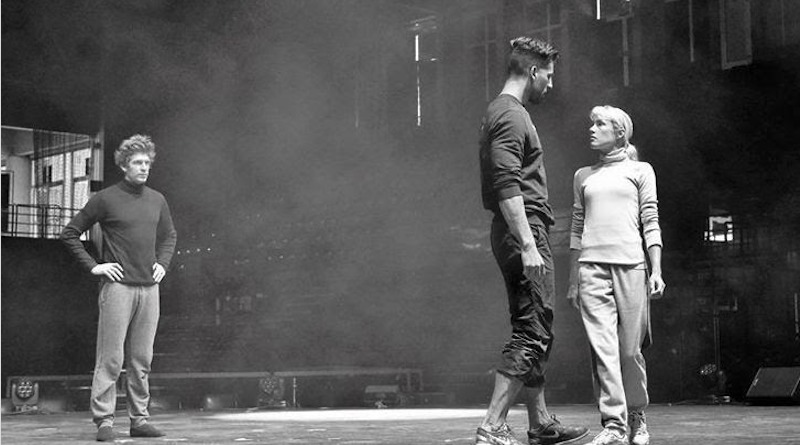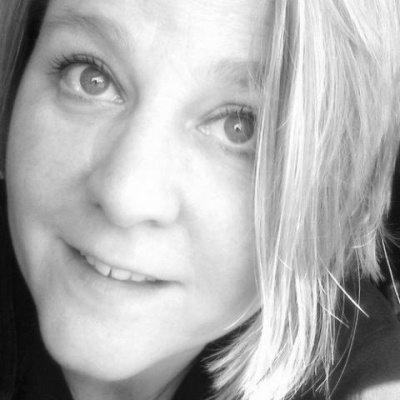Make the Transition from Circus Artist to Circus Director, Tips from Joel Baker
Joel Baker is a seasoned theater clown whose work has spanned the globe. Known for his unique brand of physical comedy, acrobatics, and improvisation, he is a graduate of San Francisco’s Clown Conservatory and the San Francisco Circus Center, where he first began incorporating hand-balancing into physical comedy. For seven years, Baker was a key performer—and also served as an artistic coach—in the Cirque du Soleil show The Beatles’ LOVE in Las Vegas. Baker has also performed the main clown roles in LOFT by The 7 Fingers and SOAP. Other recent engagements include five years with the Palazzo dinner theater show GLÜCKSJÄGER in Germany and Austria as well as the lead character role in CIRKOPOLIS by Cirque Eloize. Although his performing days are in no way behind him, in recent years he has ventured into directing circus as well, directing multiple shows for Circus Bella and the Nevada Ballet Choreographer’s Showcase and in three seasons with the show ALIS in Italy’s Le Cirque World’s Top Performers. He also teaches act creation at the San Francisco Circus Center.
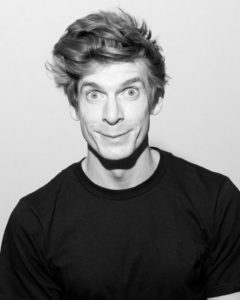 In 2020, Baker was slated to be the guest director for NECCA‘s ProTrack graduating class, an opportunity he was excited about. But the coronavirus pandemic put a halt to circus school graduations around the globe for 2020, and NECCA was no exception. I spoke to Baker about his disrupted plans, how he became a director and asked for his advice for performers looking to make the transition into directing.
In 2020, Baker was slated to be the guest director for NECCA‘s ProTrack graduating class, an opportunity he was excited about. But the coronavirus pandemic put a halt to circus school graduations around the globe for 2020, and NECCA was no exception. I spoke to Baker about his disrupted plans, how he became a director and asked for his advice for performers looking to make the transition into directing.
Kim Campbell: Joel, you were all set to direct the graduating student show with NECCA’s pro track class for 2020 when coronavirus put a stop to everyone’s plans. Tell us a little about the situation.
Joel Baker: I was first approached by NECCA about directing the graduation show in April of last year and was on tour with Cirque Bouffon in Germany. It wasn’t until fall that I was back home to focus on the project and had plans to fly out to Vermont in April 2020 to start working with the Pro Track 3rd year graduates. I had time and space to be inspired, and created the concept Janus, after I started getting to know the students, learn their skills and strengths. With March came the coronavirus and things happened fast. It’s been stressful. NECCA had to let go of their entire coaching staff. Many students lost their jobs too. We had hoped we could create the show online. We held out until a few days before I was supposed to fly out. But it just wasn’t feasible for the center financially or for the students to be together physically. Creating a joint show separately would have created a new show entirely.
KC: Can you speak to the backup plan for NECCAS graduates yet? Will there be a makeup show?
JB: I know NECCA wants to give the students some sort of graduation, but at this point, neither I nor the students know what’s going to happen. Hopefully, either a show or a video of their performances will be put together this summer.
An amazing, true sense of wonder can be created without an elaborate set, focusing on the connection an artist needs on stage to the public, using the music and lights in interesting ways in a space that may not be able to be totally transformed.
KC: What are some differences between directing a student show, a graduate show and a professional show?
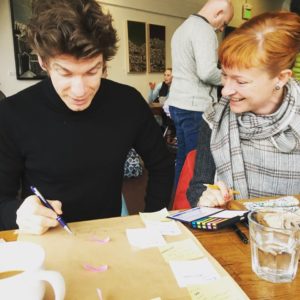
JB: I would say professionally and artistically there isn’t a lot of difference in how I work to create any show. No matter if it’s a kids’ show, graduate show, or high budget show, I’m always using every creative tool I have to bring great ideas into the project. I think the only difference comes in with the performers themselves. Every circus artist has a different level of experience. I search for what makes them unique and interesting no matter their level. With students or new performers, it’s cool to be able to pass down the kind of guidance and knowledge I received from working with some of the best directors and performers in the industry. You work with and make the best with what you have with smaller budgets, too. An amazing, true sense of wonder can be created without an elaborate set, focusing on the connection an artist needs on stage to the public, using the music and lights in interesting ways in a space that may not be able to be totally transformed.
KC: How and when did you decide to transition into directing from performing?
JB: During my years performing in the Cirque du Soleil show LOVE, I had opportunities come up and jumped at the chance. I create my own numbers, which are stories, and was used to being the thread of shows by creating transitions for different shows, so I feel like I’ve always been a creator and have practiced weaving the moving pieces together in a sense. I believe being a good clown means being a good storyteller, which crosses over into directing. My first collaboration as a director involved creating an act with the Nevada Ballet and Cirque du Soleil directing modern dancers for a production in the annual Choreographer’s Showcase. After that, I was hired by my artistic director at Cirque du Soleil as an artistic coach, teaching new performers and back-up artists acting, stage cues, role specifics, and intention for stage performance. More opportunities started to emerge, and for me this meant I was on the right path.
KC: What is the split for you now between performing/teaching/directing and do you think the pandemic will have a lasting effect on that split?
JB: I’m not performing at all right now because of the shelter-in-place and the quarantine all over the world, sadly. I hope that changes by summer at least and some of my contracts survive COVID-19. I’m still creating new acts, though, and training while directing online as much as possible, helping individuals or duos create new acts and shows or fine-tune performances. I think we in the circus community still have to get used to the idea that this can be done remotely, but it works! And it’s a good way to keep plowing away at creation.
I believe being a good clown means being a good storyteller, which crosses over into directing.
KC: Who is your directing mentor and where would you say you earned your directing chops?
JB: Gypsy Snider (founding member of Les 7 doigts de la main) was one of my early mentors and my director in three different show projects. Working with Gypsy at the beginning of my career as a performer was not only life-changing but helped set the standard for the kind of work I create, perform, and appreciate. She has the old school work ethic mixed with everything contemporary and human, and she has a great imagination. I still pull a lot from my experience working with her when I direct.
I was hired to be the assistant director for a new show in Italy. It was a very sink or swim kind of experience. I assisted in everything from the casting process and creative process to lighting and sound cues. I did that for three seasons of the show. I feel that to be good at directing means to understand how to be onstage and what works as a performer. So, it’s important to me also to be on stage and try the ideas I have for myself as a clown.
KC: What basic elements do you like to include in all of your circus shows?
JB: For every new project, it’s important for me to create a nice sense of wonder, humor, and connection to the audience. I think these elements will be especially important in shows after the pandemic. For the public to feel like they are emotionally involved in some way with what’s happening on stage, that they laugh, even after they feel the genuine risks we take as circus artists, is important and will be more so moving forward.
KC: Can you talk a bit about your directing methodology? Do you devise with artists or prefer to start with a strong theme or story?
JB: I am used to working with emotions as a clown, so I start from an emotional place when directing to create a show concept. That’s my instinct as a theatre clown. I lean toward emotionally-laden concepts simple enough to be expressed by the artists and their skills and be read by the audience. Then I let the artists use their skills to help tell the story, shape acts, stage numbers, and create transitions. I never rely only on tricks to make a show interesting. To me, that’s a little old fashioned. I need the artist to be engaged, giving their all, pulling from their life and own emotions to bring the show to the next level and evolve the story.
KC: Can you break down some of your directing processes with a few examples?
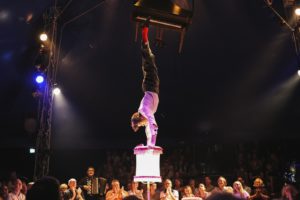
JB: I first come up with a concept that fits the situation or current times. With Janus, I thought about the transition the pro-track students had in front of them, from three years of training and getting ready to be performers. In ancient times, they might have prayed to Janus, god of transitions, for guidance before starting a new stage in their lives. That’s where the concept came for the show. I then think about the cast I have, their disciplines and their untapped strengths. After I see their act and we talk about it, I usually ask them to explore or evolve an idea I have about inner-text and theatrical images while I set the show order. I like to choose my own music so tweaks to acts are sometimes needed. I usually create the transitions, and if there’s no clown in the show, I pick someone who I can tell would be a good storyteller, someone who has a good sense of connection with the audience.
KC: What advice can you give to a circus artist who wants to transition to directing? Is there a certain amount of time and experience needed before a person is ready? What type of training can they/should they get outside of circus to prepare?
JB: It depends on the person, but I spent over a decade as a performer before I felt like I could direct. Being on stage and understanding connection, with not only the audience but with the other performers and the theatrical elements, before trying to control all those moving parts definitely helps. There are a ton of great programs in the arts, but experience is the best teacher. And going to see as many shows as possible, and a good variety is like going to class.
KC: What hope do you have for the circus sector now? How do you encourage yourself and folks in the industry to bounce back from the setbacks the coronavirus quarantines have imposed on the performing arts?
JB: I’m hopeful for a future in which we see the kind of show emerge that helps people get past the hurt and trauma of all this while also connecting with the artists or the story emotionally. We are realizing in this time of Covid-19 quarantines and isolation that human connection is so important. It adds meaning. That will have to be carried onto the circus stage moving forward.
Since the circus community is always on the go, even in modern times, now that we’re all stuck at home, it’s encouraging to see how we band together, taking time to meet for online video chats more than ever and sharing resources to help make it through this together. I think by sharing, connecting, and collaborating, while always working on new ideas, is how we’ll bounce back from this, and hopefully sooner rather than later.
With NECCA Students

In preparation for coming together during our creation period on JANUS, I had asked each student to work on a task. The Greek god Janus was to act as an usher and inspiration for the artists for this show was about transitions. The show concept was about the students and their personal transitions from who they were before starting circus school and who they have become by graduation. I had one student (Brooke Locke) who besides pole also does acro dance. I thought to use her for transitions. So, for example, one task I gave her was to play with reflection and acrylic mirrors in acro dance, to start to find interesting images and possibilities with the props I had sent over there to prepare for tying the acts together when I would arrive.
Feature photo: Directing on stadium tour in Italy; Thomas Evans and Audrey Labeau duo trapeze act. Photo Credit: Joel Baker. All photos courtesy of Joel Baker...
Do you have a story to share? Submit your news story, article or press release.

